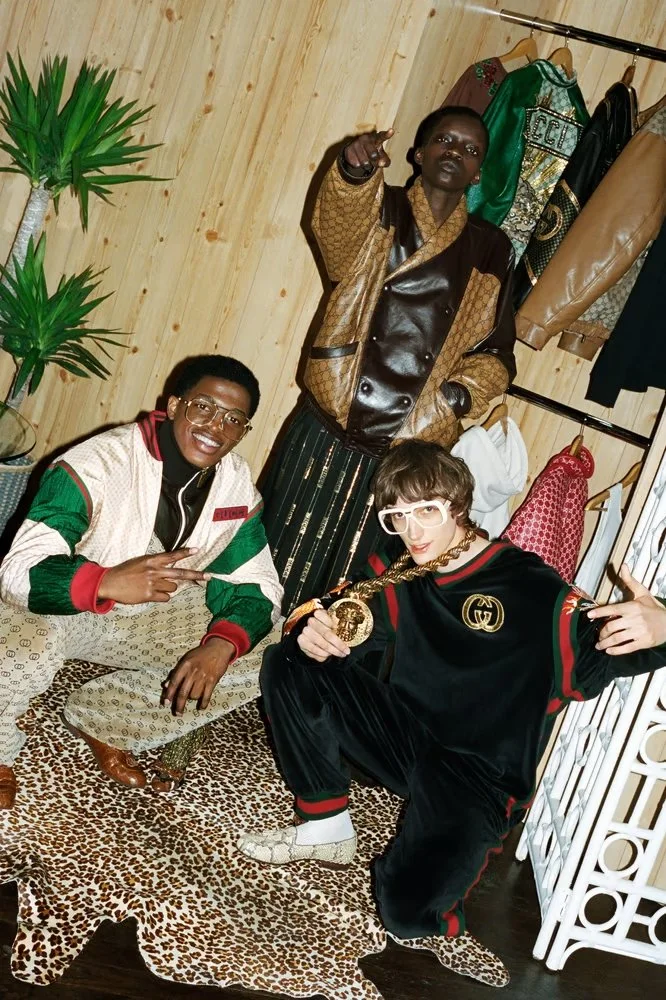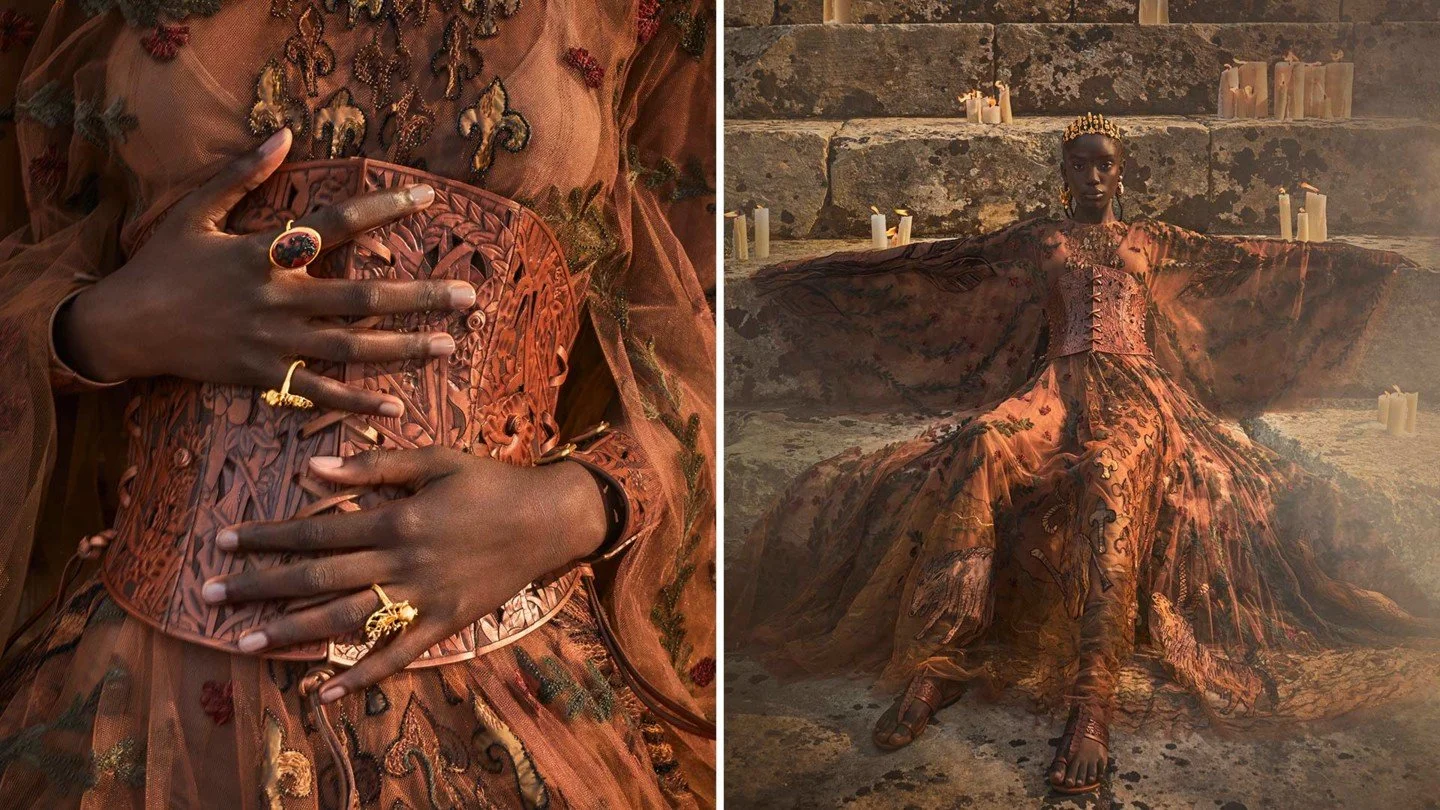Appropretiation
The thin ice of cultural inspiration has aroused many accidents on its slippery surface. The recent boom of indigenous designs among brands has awakened another wave of scandals. And while many regard this as a frivolous movement towards a wide range of cultural backgrounds, some don't see the fuss of the ongoing debate. Meanwhile, for some brands, the culture is their calling ground, for others usage of cultural motives is solemnly a source of additional income and easy-to-spot-ready-to-use narratives that passed the timeless testing. Should we try to spot the ethical side of cultural appropriation, and is it even tangible to claim authenticity and rights in the globalized and interconnected world? Appropriation, appreciation, or rather appropretiation.
A Paracosm / F Word Magazine Photoshoot by Tiago Lopes. © All rights belong to their respective owners. No copyright infringement intended.
Fashion appropriation has many faces, but its definition is surprisingly unanimous—the use of elements of one culture by members of another culture in ways that are perceived as unacknowledged or inappropriate (Young and Brunk, 2009; Ziff and Rao, 1997). Leading to the exploitation of one's cultural symbols, the phenomenon of fashion appropriation indeed gained a bad reputation within the wild circles. Even those who aren't aware of the latest fashion trends are informed on the topic, which cannot fascinate.
The ice is as thin as the frost crust on a December lake. What adds more interest to this topic is the concept of cultural appreciation that entails quite an arbitrary perspective and relates to the recognition and deep honouring of one's culture, as seen in the ethical usage of original cultural elements. And just like in the case of Yin and Yang, the different sides of the spectrum are, eventually, the same meeting ends. The only visible feature within the terminology is that while appreciation promotes understanding and respect, appropriation often reinforces stereotypes and power imbalances.
The historical context of cultural "borrowings" is also extremely interesting, taking its roots way before the fast-fashion allure emergence. At the beginning of beginnings stood the Silk Road—the main amplifier of the exchange of textiles and, thus, styles between the Asian and European worlds. During the Colonial Era, many colonizing societies also enriched their fashion baggage with elements borrowed from colonized regions, such as batik from Indonesia or paisley patterns from Persia (frequently without acknowledgement of their cultural roots). The 1970s/80s gave rise to subculture movements, blending the borders of African American and Native American motives. The hip-hop and punk styles were the pinpoints of controversial mixtures. And what about the good old present? Well, in recent years, brands have faced backlash for incorporating indigenous designs, such as Navajo patterns or Maori tattoos, into their collections without proper representation or collaboration with the originating communities.
What lessons can we learn from history? First of all, the context matters. The meanings behind attires and symbols are indeed the main stumbling blocks of the whole discussion. When used without one's acknowledgement, trivialization is inevitable.
Another topic to bring to the table is the detrimental impact such usage has on authentic communities. The economic disempowerment led by some of the fashion appropriators is enormous. When brands commercialize cultural designs without fair compensation or credit, they deprive the originating communities of financial opportunities. Indigenous artisans may find their traditional crafts overshadowed by mass-produced imitations (not the best-case scenario out there). And we haven't even brought up the issues of social hierarchies hidden within the cultural symbols. The social marginalization can be reinforced with ease by the unethical representation and misinterpretation by both consumers and designers.
The only way to actually solve the puzzle of fashion appropreciation is to reinforce the ethical "borrowings" of cultural elements. Working closely with a team of indigenous artists can ensure the correct usage of certain symbols and help the culture flourish rather than discriminate itself. Ethical sourcing and prior research are the best guides for those who are aiming to grab inspiration from others. At the end of the day, the final destination is to spotlight the beauty of unseen corners and let the publicity taste the bits of odds. The legendary Gucci-Dapper-Dan Collection is one of those cases of classy and glamorous cross-cultural collaborations. Working alongside Harlem's Fashion Row known for its diversity promotion, Gucci managed to showcase a unique blend of Afro-American motives reinforced by richness of culture and boldness of Black communities in fashion.
Photo From the Ari Marcopoulos/ Shot Gucci x Dapper Dan Lookbook. © All rights belong to their respective owners. No copyright infringement intended.
Another classic luxury brand to create a successful fashion story is Dior. For their 2021 Cruise Collection, Dior collaborated with Indigenous Australian artists to create designs that reflected Aboriginal culture (and did it extremely handily). Telling the tale of bloomy lands, the collection captures the vivid spirit of Australia in its magnificent and romantic allure.
Dior 2021 Cruise Collection Depicting Indigenous Australian Symbols. © All rights belong to their respective owners. No copyright infringement intended.
As we can see, telling the tale of one's culture without showing the "yellow lights" or, what's worse - "red lights," is not only achievable but also extremely prosperous. If used correctly, cultural motives can easily capture the beauty and uniqueness of one's culture without following the beaten road of fetish and marginalization.
The verdict is here, and it's more evident than ever—the route of appropriation has indeed lost sight. And while the blacks and whites are too dubious to be detected, the appopretiation allows us to bring on a unique perspective towards conflicting ends. Surely, this piece offers some future discussion prospects, such as the overall ethics of cultural references, as the romanization of faraway lands can be easily seen as the fetishization of "one-of-a-kind".
Indeed, the mysterious allure of East "Oh, I come from a land, from a faraway place... It's barbaric, but hey, it's home" is visible in many pop-culture gestures. The term orientalism has been around for quite some time to talk us through the exoticizing and almost ecstatic state of Western depiction of the so-called "barbarian and magical East".
In the modern realm, another grand player has come to the scene. Asian culture's lavishness is omnipresent, fueling a global fascination. Showcasing the Western-centric reinterpretation of East Asian cultural phenomena, like K-pop, anime, and fashion, it is tailored specifically for those seeking the sweet lush of unknown heritage. Harajuku or Shibuya districts have already come into European streets, mimicking the bold self-expression of Japanese streetwear, initially highlighted by a couple of historical and social nuances.
Nevertheless, the thin line of the dispute is still here to be unpacked and rotated under many spectacles. What we, as consumers, can do is hold our guard and seek meaningful references to those of cheap and vulgar beginnings. In the globalized and interconnected world we live in, the question of ethics and authenticity isn't even prevalent—it's omnipresent. Meaningful narratives are the only way of promoting rather than diminishing one's roots, and it's the main obstacle to the appropretiation phenomenon. By being mindful of the symbols we engage with and the stories we choose to amplify and believe in, we can grow the new prospect—more equitable and respectful. Appropriation, appreciation, or rather appropretiation?



